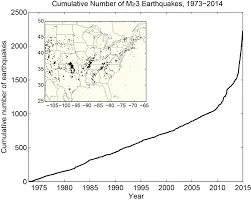Report: Earthquakes tied to oil and gas wastewater injection rising in US

Earthquakes linked to injection of wastewater from oil and natural-gas development have increased sharply since 2009 in the central and eastern U.S., including in Colorado, according to a new study by the U.S. Geological Survey.
Researchers listed Greeley as one of the 17 zones where oil and gas wastewater injection may have caused induced seismicity, according to the report released Thursday. Scientists also looked at earthquake activity in Oklahoma, New Mexico, Arkansas, Kansas, Texas, Ohio and Alabama.
Scientists developed hazard models by analyzing earthquakes in these zones and considering their rates, locations, maximum magnitude and ground motions.
“The proportion of small-to-large earthquakes is…
THIS ARTICLE IS FOR SUBSCRIBERS ONLY
Continue reading for less than $3 per week!
Get a month of award-winning local business news, trends and insights
Access award-winning content today!
